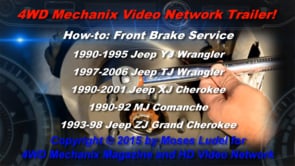1990-2006 Jeep Front Brakes Service and Pad Replacement…
This HD video is the trailer for a full-length 24:49-minute brake service video, part of a how-to series available at Vimeo On Demand. In the front disc brake segment, Moses Ludel shares the replacement of brake pads, rotors and related parts on these Jeep models: 1990-95 Jeep YJ Wrangler; 1997-2006 Jeep TJ Wrangler; 1990-2001 Jeep XJ Cherokee; 1990-92 Jeep MJ Comanche and the 1993-1998 Jeep ZJ Grand Cherokee. (1990-91 Jeep Grand Wagoneer models do not use this braking system.) The how-to video series covers all work and emphasizes both safety and quality workmanship.
Note: The full-length version of this video is part of a complete front and rear brake service series available at the magazine’s Vimeo On Demand channel. Click this link for direct access to the Vimeo On Demand how-to HD video. This 30-day streaming rental covers disc brake pad and rotor replacement for the Jeep® models described…You will also find other streaming rental how-to videos at: 4WD Mechanix Video Network at Vimeo On Demand.


The full-length 24:49-minute HD video is a detailed step-by-step for servicing the front disc brakes on these popular Jeep models. Work includes removal of the calipers and rotors, parts inspection and installation of new rotors and disc brake pads. Shown here are the old brake pads and prepping the new brake pads for installation into the calipers. The video information is model-specific and illustrations are clear. If you own a Jeep in this model and year range, you will find the details needed to replace front disc brake pads and rotors.


If your vehicle does not require caliper replacement or rebuilding, this work can be performed without the need to bleed the brakes. When retracting the pads, be careful not to overfill the master cylinder reservoir. If necessary, draw out excess brake fluid with a clean syringe or siphon bulb…Watch the fluid level and do not run the fluid too low. Too low and the system will draw air, which requires bleeding. At right is a clean brake fluid reservoir fill device to keep the fluid from dropping too low…If the fluid is dark or more than a few years old, you should flush the system thoroughly with fresh brake fluid of the proper type and bleed the brakes of all air. OEM (original equipment) fluid on these models is DOT 3 or upgrade DOT 4. Do not mix DOT 3/DOT 4 fluid types with DOT 5 (silicone type brake fluid). DOT 4 offers better heat/boiling protection and is compatible with DOT 3 brake fluid. Read labels carefully when purchasing brake fluid.
Keep the hydraulic system clean and free of debris during service work. Use quality brake pads, rotors and calipers. Inspect hoses for damage, and do not twist or stretch hoses during service work. If necessary, replace worn hoses and bleed the system. Make sure the hoses are not twisted or misaligned during assembly. Pay attention to these details in the video. Brake safety is the focus. If calipers or rotors need replacement, purchase known product brands. New rotors shown in this project are genuine Bendix. Brake pads are high grade non-asbestos type.

